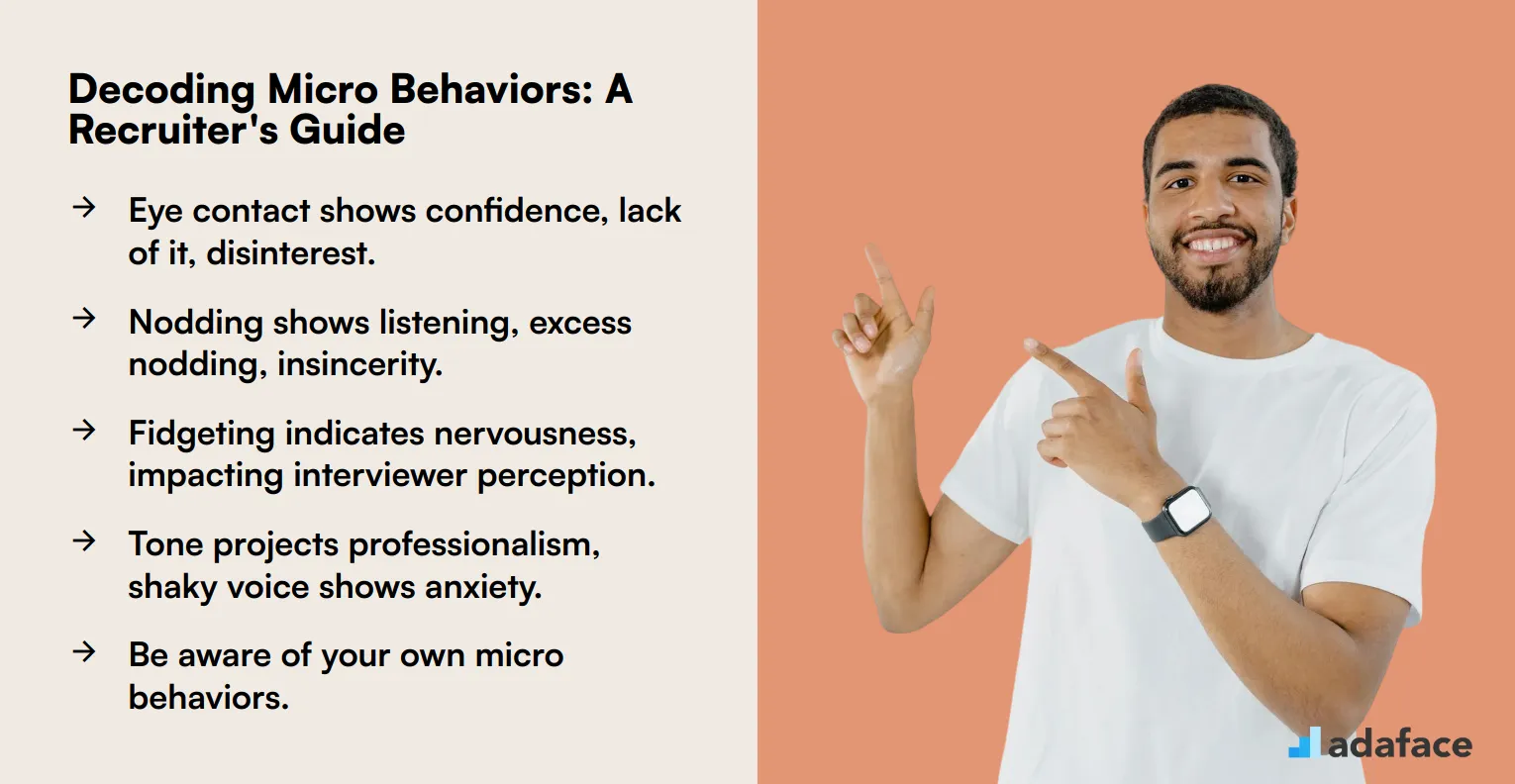Micro behaviors are subtle actions or reactions that can influence the outcome of recruitment interviews. Recognizing these behaviors can be crucial for recruiters aiming to make fair and informed hiring decisions.
In interviews, micro behaviors can either positively or negatively impact the perception of a candidate. By identifying these behaviors, recruiters can enhance their selection process and ensure a more objective evaluation.
Table of contents
What are micro behaviors?
Micro behaviors refer to the small, often subconscious actions or reactions that individuals exhibit in various situations. These can include gestures, facial expressions, tone of voice, and even subtle shifts in posture.
In the context of recruitment and HR, understanding micro behaviors can provide insights into a candidate's personality and potential fit within a team. For instance, consistent eye contact might indicate confidence, while fidgeting could suggest nervousness or discomfort.
Recruiters and hiring managers can use observations of micro behaviors to complement traditional assessment methods. This can aid in making more informed hiring decisions by revealing traits that are not easily captured through resumes or interviews alone.
Micro behaviors are particularly useful when evaluating interpersonal skills and emotional intelligence. They can help identify candidates who are likely to excel in roles requiring strong communication and collaboration skills.
By paying attention to these subtle cues, recruiters can enhance their hiring process and ensure a better match between candidates and job roles. This approach contributes to building a more cohesive and effective team.
Common micro behaviors in interviews
Micro behaviors in interviews are subtle, often unconscious actions or expressions that can significantly impact the interview process. These can include body language, tone of voice, facial expressions, and small verbal cues that interviewers and candidates may not even realize they're exhibiting.
One common micro behavior is maintaining eye contact, which can convey confidence and engagement. Conversely, avoiding eye contact might be interpreted as disinterest or dishonesty, potentially affecting the interviewer's perception of the candidate.
Nodding and smiling are positive micro behaviors that show active listening and agreement. However, excessive nodding or forced smiles can come across as insincere or overeager, potentially undermining the candidate's credibility.
Fidgeting, such as tapping fingers or bouncing legs, can indicate nervousness or impatience. These behaviors might distract the interviewer or give the impression that the candidate is uncomfortable or lacks confidence.
Tone of voice and speaking pace are also important micro behaviors to consider. A calm, measured tone can project confidence and professionalism, while speaking too quickly or with a shaky voice might suggest anxiety or lack of preparation.
Interviewers should be aware of their own micro behaviors as well, such as checking the time frequently or appearing distracted. These actions can make candidates feel undervalued or rushed, potentially affecting their performance and overall interview experience.

Positive vs negative micro behaviors
Micro behaviors in recruitment can be categorized as positive or negative, impacting the interview process and candidate perception. Positive micro behaviors include active listening, maintaining eye contact, and providing constructive feedback, fostering a welcoming atmosphere.
Negative micro behaviors, such as interrupting candidates or displaying disinterest, can create an uncomfortable environment and discourage open communication. Recognizing these behaviors helps recruiters enhance the candidate experience, ensuring a fair and engaging process.
Positive micro behaviors also involve using inclusive language and acknowledging diverse perspectives, promoting a sense of belonging for all candidates. Conversely, negative behaviors might include biased questioning or making assumptions based on stereotypes, which can lead to unfair assessments.
By focusing on positive micro behaviors, recruiters can build trust and rapport with candidates, improving the overall recruitment process. This approach not only benefits the candidates but also enhances the organization's reputation as an inclusive and fair employer.
Recognizing your own micro behaviors
Recognizing your own micro behaviors as a recruiter or hiring manager is a fundamental step in refining your recruitment strategies. These subtle actions, such as nodding during an interview or maintaining eye contact, can significantly influence a candidate's perception and the overall interview outcome.
Self-awareness is key to identifying these micro behaviors. By being mindful of your gestures and tone, you can ensure that your actions align with the values and culture you wish to project to potential hires.
Reflecting on past interviews can also provide insights into your micro behaviors. Consider how candidates have reacted to your actions and whether your behavior might have unintentionally conveyed bias or favoritism.
Regular feedback from colleagues can be invaluable in recognizing and adjusting your micro behaviors. A trusted peer can offer an external perspective, helping you to understand how your actions are perceived by others.
Finally, training sessions or workshops focused on interviewer bias can further enhance your awareness. By understanding common biases and how they manifest in micro behaviors, you can work towards a more objective and fair recruitment process.
Addressing micro behaviors in candidates
Addressing micro behaviors in candidates during interviews is a subtle yet impactful practice for recruiters and hiring managers. These small, often unconscious actions can provide valuable insights into a candidate's suitability for a role, complementing more traditional assessment methods like behavioral competency.
Micro behaviors can reveal a candidate's interpersonal skills, adaptability, and attention to detail. For instance, consistent eye contact might indicate confidence and engagement, while fidgeting could suggest nervousness or discomfort.
By paying attention to these behaviors, interviewers can gain a deeper understanding of a candidate's personality and potential fit within the team. This approach aligns well with values-based recruitment, where cultural fit is as important as technical skills.
It's important for interviewers to remain objective and avoid letting personal biases influence their interpretation of micro behaviors. Tools like structured interviews can help mitigate perception bias and ensure a fair evaluation process.
Incorporating micro behavior analysis into your recruitment strategy can enhance decision-making and improve hiring outcomes. It allows for a more nuanced understanding of candidates, ultimately leading to better hiring decisions.
Training interviewers on micro behaviors
Training interviewers to recognize and understand micro behaviors can significantly improve the hiring process. It helps them to make more informed and fair decisions.
Think of micro behaviors as tiny signals that reveal a candidate's true personality and potential. They are subtle actions, words, or expressions that can tell you a lot about a person beyond what's written on their resume. Understanding these nuances can help you assess the candidate's person-organization fit.
Start by making interviewers aware of common biases, like the halo and horn effect, which can influence their perception. Teach them to focus on specific, observable behaviors rather than making assumptions based on gut feelings.
Provide examples of positive and negative micro behaviors to illustrate their impact. For instance, active listening, such as nodding and maintaining eye contact, can indicate engagement, while dismissive gestures might signal disinterest. This helps the interviewer in quality of hire.
Encourage interviewers to ask open-ended questions that prompt candidates to demonstrate these behaviors. Role-playing exercises can also be beneficial, allowing interviewers to practice identifying and interpreting micro behaviors in a safe environment.
Finally, emphasize the importance of self-awareness. Interviewers should also be mindful of their own micro behaviors and how they might affect candidates.
Conclusion
Understanding micro behaviors can significantly enhance the recruitment process. By being mindful of these subtle cues, interviewers can make more informed hiring decisions.
Training interviewers to recognize and address micro behaviors is a valuable investment. It helps create a more inclusive and fair interview experience for all candidates.
Incorporating micro behavior awareness into your recruitment strategy can lead to better hiring outcomes. Remember, every small detail can make a big difference in finding the right fit for your team.
Micro Behaviours FAQs
Micro behaviors in recruitment refer to small, often unconscious actions or reactions by candidates or interviewers that can influence the hiring process.
Recruiters can identify micro behaviors by paying close attention to body language, tone of voice, and facial expressions during interviews.
Positive micro behaviors can enhance a candidate's chances by creating a favorable impression, indicating confidence, and showing engagement.
Negative micro behaviors should be addressed by providing feedback to candidates and training interviewers to minimize bias and improve evaluation.
Training on micro behaviors helps interviewers conduct more objective assessments, reducing bias and ensuring fair hiring practices.

40 min skill tests.
No trick questions.
Accurate shortlisting.
We make it easy for you to find the best candidates in your pipeline with a 40 min skills test.
Try for freeRelated terms



